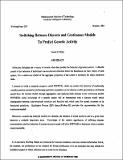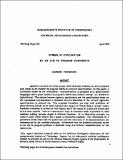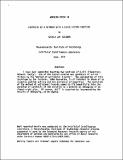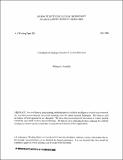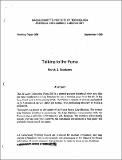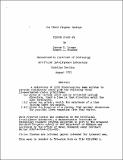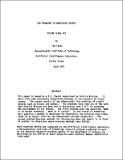Browsing AI Working Papers (1971 - 1995) by Title
Now showing items 242-261 of 291
-
Switching Between Discrete and Continuous Models To Predict Genetic Activity
(MIT Artificial Intelligence Laboratory, 1983-10)Molecular biologists use a variety of models when they predict the behavior of genetic systems. A discrete model of the behavior of individual macromolecular elements forms the foundation for their theory of each system. ... -
Symbol IC-Evaluation as an Aid to Program Synthesis
(MIT Artificial Intelligence Laboratory, 1976-04)Symbolic-evaluation is the process which abstractly evaluates an actor program and checks to see whether the program fulfills its contract (specification). In this paper, a formalism based on the conceptual representation ... -
Synthesis of a Network with a Given System Function
(MIT Artificial Intelligence Laboratory, 1974-06)I have just completed teaching two sections of 6.011 (Elementary Network Theory). One of the topics covered was synthesis of active filters by the "method of unilateral 2-ports". The explanation of this technique by the ... -
A Synthesis of Language Ideas for AI Control Structures
(MIT Artificial Intelligence Laboratory, 1980-07)Two well known programming methodologies for artificial intelligence research are compared, the so-called pattern-directed invocation languages and the object-oriented languages. The features and limitations of both ... -
Talking to the Puma
(MIT Artificial Intelligence Laboratory, 1982-09)The AI Lab's Unimation Puma 600 is a general-purpose industrial robot arm that has been interfaced to a Lisp Machine for use in robotics projects at the lab. It has been fitted with a force-sensing wrist. The Puma is capable ... -
TEMPEST -- A Template Editor for Structured Text
(MIT Artificial Intelligence Laboratory, 1984-05)This paper proposes an editing tool named TEMPEST (TEMPlate Editor for Structured Text) whose goal is to extend a text editing environment by using templates to incorporate into it some knowledge of the structure of the ... -
Test Programming by Program Composition and Symbolic Simulation
(MIT Artificial Intelligence Laboratory, 1985-11)Classical test generation techniques rely on search through gate-level circuit descriptions, which results in long runtimes. In some instances, classical techniques cannot be used because they would take longer than the ... -
A Theory of Plans for Electronic Circuits
(MIT Artificial Intelligence Laboratory, 1977-04)A plan for a device assigns purposes to each of the more primitive components and explains how these components interact to achieve the desired behavior of the composite device. Such an information structure is critically ... -
Tomorrow's Surgery: Micromotors and Microrobots
(MIT Artificial Intelligence Laboratory, 1992-07)Surgical procedures have changed radically over the last few years due to the arrival of new technology. What will technology bring us in the future? This paper examines a few of the forces whose timing are causing new ... -
Toward a Principle-Based Translator
(MIT Artificial Intelligence Laboratory, 1985-06)A principle-based computational model of natural language translation consists of two components: (1) a module which makes use of a set of principles and parameters to transform the source language into an annotated surface ... -
Toward a Richer Language for Describing Software Errors
(MIT Artificial Intelligence Laboratory, 1985-05)Several approaches to the meaning and uses of errors in software development are discussed. An experiment involving a strong type-checking language, CLU, is described, and the results discussed in terms of the state of the ... -
Towards a Better Definition of Transactions
(MIT Artificial Intelligence Laboratory, 1979-05)This paper builds on a technical report written by Carl Hewitt and Henry Baker called "Actors and Continuous Functionals". What is called a "goal-oriented activity" in that paper will be referred to in this paper as a ... -
The TRACK Program Package
(MIT Artificial Intelligence Laboratory, 1973-08)A collection of LISP functions has been written to provide vidisector users with the following three line-oriented vision primitives: (i) given an initial point and an estimated initial direction, track a line in that ... -
Tracking Wires on Printed Circuit Boards
(MIT Artificial Intelligence Laboratory, 1973-10)This working paper describes a collection of LISP programs written to examine the backs of printed circuit boards. These programs find and trace the conductive wires plated on the insulating material. The "pads", or solder ... -
Tradeoffs in Designing a Parallel Architecture for the Apiary
(MIT Artificial Intelligence Laboratory, 1984-12)The Apiary is an abstract computer architecture designed for performing computation based on the idea of message passing between dynamic computational objects called actors. An apiary connotes a community of worker bees ... -
Transcendence, Facticity, and Modes of Non-Being
(MIT Artificial Intelligence Laboratory, 1986-03)Research in artificial intelligence has yet to satisfactorily address the primordial fissure between human consciousness and the material order. How is this split reconciled in terms of human reality? By what duality is ... -
Transparency
(MIT Artificial Intelligence Laboratory, 1975-07) -
TRIG: An Interactive Robotic Teach System
(MIT Artificial Intelligence Laboratory, 1982-06)Currently, it is difficult for a non-programmer to generate a complex sensor-based robotic program. Most robot programming methods either generate only very simple programs or are such that they are only useful to programmers. ... -
Two Problems in Analyzing Scenes
(MIT Artificial Intelligence Laboratory, 1971-06)This paper is based on a B.S. thesis supervised by Patrick Winston. It deals with some previously unexplored problems in the analysis of visual scenes. The scenes consist of two dimensional line drawings of simple objects ... -
Two Simple Algorithms For Displaying Orthographic Projections of Surfaces
(MIT Artificial Intelligence Laboratory, 1976-08)Two simple algorithms are described for displaying orthographic projections of surfaces. The first, called RELIEF-PLOT, produces a three-dimensional plot of a surface z = f(x,y). The second, called SHADED-IMAGE, adds ...
